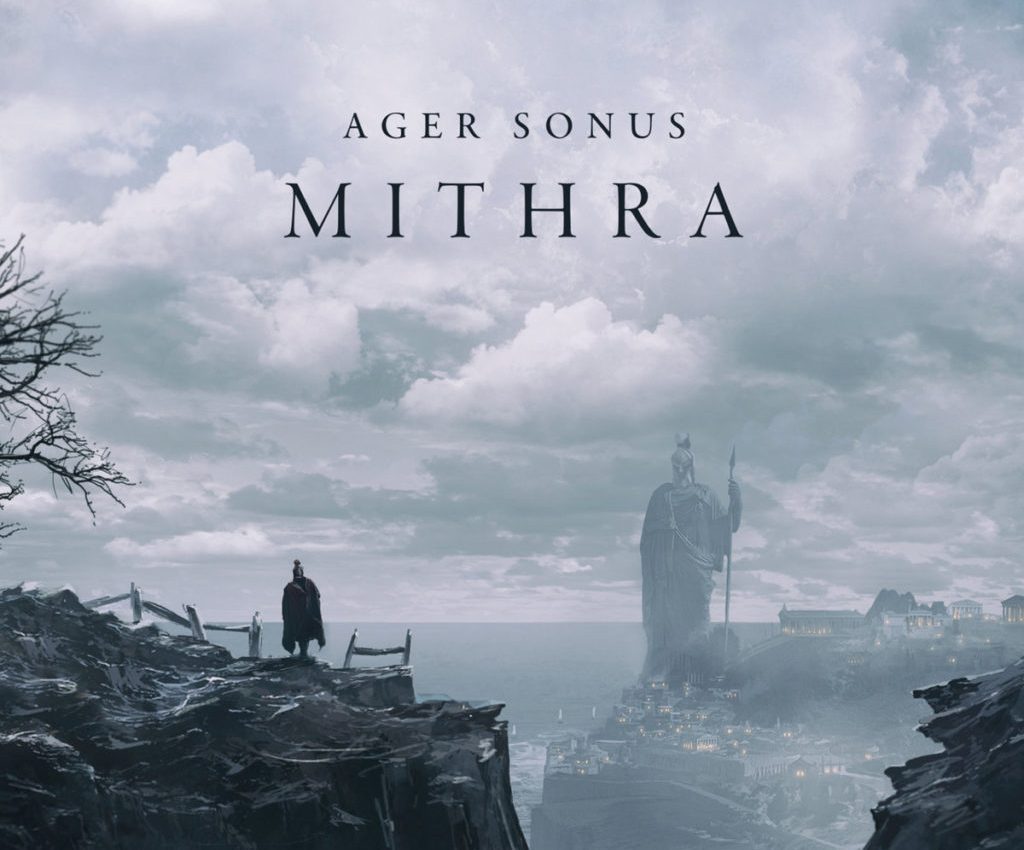[dropcap style=”font-size:100px; color:#992211;”]F[/dropcap]rom listening to and reading about ambient and drone recordings over the years it appears that sound judgements and sonic appraisals revolve around a few core elements: texture; narrative and setting; process and technique; and recurrence.
The 2019 releases of Solitude by France Jobin (Silent Records) and Mithra by Ager Sonus (Cryo Chamber) are a good chance to think about these elements as they relate to two current directions in ambient/drone music: abstract formalism and grafisk världsbyggnad.
For what it’s worth it doesn’t appear that there is much difference between ambient and drone other than a varying association with melody, historically. Readers may note that drone included less figurative sounds created using generative sound modules (e.g., blender through a wah pedal with excessive reverb and delay) and ambient had a lot more wood flute. These days the differences are negligible as both borrow heavily from each other, with blended wood and wah flutes abound.
Abstract formalism is a trope in ambient music which rehashes recognisable elements of Brian Eno’s Music for Airports, touches of Aphex Twin’s Selected Ambient Works, and the rolling piles of noise associated with visionaries such as William Basinski (“dlp 1.1”), Merzbow and Rapoon. Characteristically there are certain repeating atmospheres which are interspersed with light-fingered melodies and breathy washes of synth pad or a foley equivalent (waves, wind, traffic noise, cat snores). Repetition and evolving structures is probably the most central aspect of this type of ambient, with many artists using the loop characteristics of MaxMSP, AudioMulch or pedals to create trance-inducing fugues. Artists have used these tropes successfully, but bearing in mind that they did so at least 20 years ago, releasing more of the same is getting monotonous… and not in a fun way.
Within visual art Walter Robinson has described a trend which he terms ‘zombie formalism‘, a sort of abstract expressionist art that rehashes tropes from the 40s and 50s in order to sell familiar concepts to a buying public looking to pleasantly cover walls. Others have dismissed this audience-led movement as emphasising the design and decorative aspects of art as a craft rather than an intellectual pursuit. Whether by lack of imagination or technical ease, formal ambient musicians seem to be moving towards greater homogeneity and that ‘ambient sound’ rather than pursuing markedly individual or forward reaching visions of their own. Perhaps the world has caught up, but even luminaries such as Brian Eno, Burial and Tim Hecker have arguably stopped pushing the (LFO) envelope as radically as they once did. Moreover, many new voices in ambient seem to be following suit and only putting out incrementally different takes on old masters rather than smashing the firmament.
The other movement in ambient music we might describe grafisk världsbyggnad (graphic world-building, GV) because it conjures a specific and figurative time or place — usually Scandanavia. Emerging from the deep listening practices of Pauline Oliveros and Steven M. Miller, social and ecological motifs are used to convey the spirit of an imagined place. Releases of this sort tend to be extended conversations around themes of loneliness and melancholy in a variety of exotic settings, much like a teenager on a family trip. While recently there have been steps to expand on the stock set of ambient idyls, the old favourites remain: arctic snowscapes (Biosphere); volcanic slag heaps (Lustmord); surly gardens of frost-white snowmen (Burzum); and Newcastle (Zoviet France).
Emerging from the electric-ethnologist boom of the 90s lead by acts like Deep Forest, GV took the fun out of prog and the beats out of dance, escaping to sexless vistas where music could be plotted like Tolkien’s map of Middle Earth. While its popularity has been largely lost on the wider commercial public there is a deep and loyal fanbase that purchases cassette rarities and vinyl by the tonne, and rabidly defends online forums from the casual listener. The pull of this direction lies in its deep evocation of place. However, this genre’s greatest ally lies in the video games industry where an increasing demand for incidental soundtracks has meant that a whole raft of musicians have been able to support themselves for an audience of pale thumb-fiddlers. But does this mean the music has merit outside of its background context?
As an example of abstract formalism, artists like France Jobin generally eschew context as they weave great stonking walls of harmonic noise that climb against themselves to structure ever increasing parallels of self-referential sound. On Solitude, her latest release, Jobin reaches a strangely accessible place where the unique abstraction of her 2016 releases (Singulum and Radiance II: Music for the Answer) are put aside for a more familiar sound. Despite its title Jobin’s approach gives the impression of a rather conflicted meditation punctuated by periods of heartburn. Her choice of busy processed tones which are either re-amped or run through an expanding filter give the composition a breathy, repetitious depth. Where hinting at some convoluted internal dialogue, this garrulous sonic chatter suggests angsty internal echoes; where is that T-shirt and what did she mean? However while this use of repetition doesn’t feel new it rather acts to situate the recording within a deathly familiar frame, and once novel echo-and-answer techniques à la the delay capabilities of AudioMulch/MaxMSP sound spent rather than revelatory.
This in no way makes listening to the album an unpleasant experience. As washes of tonal flourishes are severed by judicious applications of bit-crunched static the supa-triggered glitches burble like an idyllic dial-up data stream through the green meadows of a bitcoin farm, and the listener can’t help but gurn appreciatively. But smiles fade as the track never truly emerges from its encasing genre and, it being too much in the vein of artists like Rapoon, Simon Scott, Biosphere, and Pan Sonic, one never feels fully satisfied. Despite being executed with a well balanced sense of space and arc the problem here is that Solitude doesn’t feel either engagingly personal nor intellectually rigorous in a way that maintains prolonged interest.
In the end, the subject of solitude isn’t conveyed nor investigated convincingly and despite the music’s fine qualities it is too easy for the listener to be drawn away or even skip ahead. Which is a shame as there are enough ideas and captured sonic moments here to warrant further listening and mark a return to the quality of Jobin’s more singular 2016 output.
From an artist cut free from context to one immersed to the point of drowning in their own source material, Ager Sonus‘ latest release Mithra (Cryo Chamber 2019) is emblematic of the prevalent genre of ambient music’s GV.
Mithra is a reference to a classical deity of Indo-Persian (possibly to proto Aryan-Vedic Mitra) origin and a semi-sanctioned religion within the Roman Empire. Being largely secret (and according to some, still practiced by patriarchal elites to this day) the exact nature of these rituals is not wholly known and thus ripe for musical explorations into dark pledges, torch-lit ancient rituals, eldritch gods and scantily-clad sacrifices. Suitably, Mithra contains ancient modes, a sense of ritual foreboding, minor key synth progressions and muted percussion. When the record succeeds you get a sense of what that time might be like; one smells the cow dung campfires of nomadic traders, the flash of bronze on a dusk spear tip, the constant annoyance of body lice, and oodles of melancholy as you count how many wives you lost to childbirth. However, artistically you never get close to the mysterious flame that would explain why the cosmos is the way it is and what awesome truths can lead you forward.
Mithra positions itself as a release for fans of game soundtracks and it’s a solid piece of work within that constraint. That constraint requires that the work be ephemeral, and to its credit it raises itself beyond that remit to deliver something musical and in places even borders on important. It’s a humble release that we dare love and get close to, but once we start to analyse it as music it becomes hard to remain convinced. The thematic motifs are repeated too often and atmospheric elements retreat rather than build, as a result never making a comprehensive impact. Moments when the synth elements, percussion, and melodic pieces come together as in “Settlement” where washes of tones emphasise the pizzicato strings, are epic and captivating. However as in many cases on Mithra, lack of melodic development dissipates the track’s power even when a change in the timbre of the synth hints at a more compelling finale. Compared with Ager Sonus’ masterpiece “Inner Sanctum” from Book of the Black Earth (2017) Mithra is a bold foray into an evocative thematic soundscape which falls short. However, if the aim is to validate a subgenre of ambient which operates as a psycho-historical exploration of lost places it lands a few punches, even if detractors might characterise these efforts as menu screen mapscapes best clicked through.
It may seem like apples and oranges to compare these two releases, one an exercise in artistic expression and the other an exercise in evocation. Yet the common ground is that both purport to be transportive: one inward while the other absolutely elsewhere.
But what works? As with all art we ask whether in the end the work stands on its own merits and convinces us of its being and its effect. To that end we must reject the hackneyed excuse of only judging it within its own limits and stick the boot in.
France Jobin’s Solitude is artistic in a formal sense; it ticks the educational ‘sonic art’ cues so redolent of gallery-based music, however it’s not a convincing argument that it does so beyond the ‘atmospheric incidental music’ of Ager Sonus’ Mithra. They suffer equally from a sense of ambition and proportion. One has so much abstract formal pretension that the individual and personal aspects of work get lost and the other, while showing flashes of unique promise, seems satisfied with remaining an exploratory cultural exercise. Mithra is a flawed but noble exercise that lets itself down by trying to raise the genre of ‘incident video game music’ or GV. Worse still, it feels like a conscious effort to bolster Thomas Langewehr’s CV in the games industry. Both artists suffer from being formulaic and playing entirely within their genre expectations, and as a consequence the lack of surprise becomes a lack of imagination which inevitably damns. In the case of Mithra the constraints are due to a very literal if archaeological rendering of what that music might be like in the context of a strategic sim, but in the case of Jobin it’s about catering to what her peers and audience expect rather than pursuing a more personal line towards challenging musical territory. She is talented but on the basis of Solitude, while she’s returned to a more accessible musical position, it’s hard to make the case that it’s a strong step forward. It contains itself and is worth listening to but fails to make a lasting impact. The virtuoso element of ambient music is found where minimal sonic activity captivates the listener with unwavering intensity, often challenging the listener to re-evaluate what sonically we should accept as music. On this basis both releases plod.
Epilogue:
Great artists working within the GV genre are to be found on Simon Heath’s Cryochamber label and Silent Records’ Kim Cascone has championed a variety of mesmerising ambient/drone since the mid 80s. A fuller investigation of both labels’ back catalogue gives ample evidence of the heroic and avant-garde roots of two musical directions in danger of losing their edge.

The aim of art is to represent not the outward appearance of things, but their inward significance. – Aristotle




















